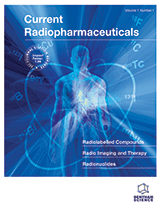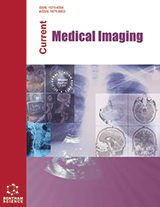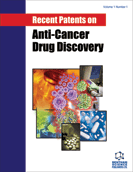Abstract
Objective: The aim of the present study was to develop a 177Lu-labeled porphyrin derivative having favorable characteristics for use in targeted radiotherapy of cancer and to evaluate its biological behavior in mouse tumor models with respect to its effectiveness in tumor regression. Owing to the inherent affinity of porphyrins to accumulate in the tumors, suitably modified porphyrin derivative was chosen as the vehicle for the targeted delivery of the radionuclide. 177Lu was preferred as the radionuclide of choice due to its suitable nuclear decay characteristics [Eβ(max) = 497 keV, Eγ = 208 keV (11%), 113 keV (6.4%)], comparatively longer half-life (6.73 d) and ease of production in adequate quantity and sufficiently high specific activity using medium flux research reactors. Methods: A novel porphyrin analogue, 5,10,15,20-tetrakis[4-carboxymethyleneoxyphenyl]porphyrin was synthesized inhouse and coupled with a macrocyclic bi-functional chelating agent, namely p-amino-benzyl-1,4,7,10- tetraazacyclododecane-1,4,7,10-tetraacetic acid. The porphyrin-BFCA conjugate was labeled with 177Lu and the biological behavior of the radiolabeled conjugate was studied by biodistribution and imaging in Swiss mice bearing either fibrosarcoma or thymic lymphoma tumors. Effectiveness of the agent in controlling the growth of tumor volumes was also studied by administering various doses of the radiolabeled preparation in the mouse tumor models. Results: 177Lu-labeled porphyrin-BFCA conjugate was prepared with high radiochemical purity ( > 99%) and adequate invitro stability. Biodistribution and imaging studies revealed good uptake and retention of the agent in the tumors with encouraging tumor to blood and tumor to muscle ratios at various post-administration time points. Tumor regression studies showed that the administration of the agent increased the average tumor doubling time and decreased the average specific growth rate substantially in both the types of tumors. However, thymic lymphoma was found to be more sensitive to the radiolabeled conjugate compared to fibrosarcoma. Conclusion: Preliminary biological evaluation and tumor regression studies carried out in two different tumor models in Swiss mice exhibited the promising nature of 177Lu-labeled porphyrin-BFCA conjugate as an agent for targeted tumor therapy. However, further detailed investigations are warranted to evaluate the true potential of the developed agent.
Keywords: Fibrosarcoma, 177Lu, porphyrin, targeted radiotherapy, thymic lymphoma, tumor regression, Transplantation, Thymic Lymphoma Tumor, Radiochemical Processing, Scintiimaging Studies
Current Radiopharmaceuticals
Title: Studies on Efficacy of a Novel 177Lu-Labeled Porphyrin Derivative in Regression of Tumors in Mouse Model
Volume: 4 Issue: 2
Author(s): Haladhar D. Sarma, Tapas Das, Sharmila Banerjee, Meera Venkatesh, Pandit B. Vidyasagar and Kaushala P. Mishra
Affiliation:
Keywords: Fibrosarcoma, 177Lu, porphyrin, targeted radiotherapy, thymic lymphoma, tumor regression, Transplantation, Thymic Lymphoma Tumor, Radiochemical Processing, Scintiimaging Studies
Abstract: Objective: The aim of the present study was to develop a 177Lu-labeled porphyrin derivative having favorable characteristics for use in targeted radiotherapy of cancer and to evaluate its biological behavior in mouse tumor models with respect to its effectiveness in tumor regression. Owing to the inherent affinity of porphyrins to accumulate in the tumors, suitably modified porphyrin derivative was chosen as the vehicle for the targeted delivery of the radionuclide. 177Lu was preferred as the radionuclide of choice due to its suitable nuclear decay characteristics [Eβ(max) = 497 keV, Eγ = 208 keV (11%), 113 keV (6.4%)], comparatively longer half-life (6.73 d) and ease of production in adequate quantity and sufficiently high specific activity using medium flux research reactors. Methods: A novel porphyrin analogue, 5,10,15,20-tetrakis[4-carboxymethyleneoxyphenyl]porphyrin was synthesized inhouse and coupled with a macrocyclic bi-functional chelating agent, namely p-amino-benzyl-1,4,7,10- tetraazacyclododecane-1,4,7,10-tetraacetic acid. The porphyrin-BFCA conjugate was labeled with 177Lu and the biological behavior of the radiolabeled conjugate was studied by biodistribution and imaging in Swiss mice bearing either fibrosarcoma or thymic lymphoma tumors. Effectiveness of the agent in controlling the growth of tumor volumes was also studied by administering various doses of the radiolabeled preparation in the mouse tumor models. Results: 177Lu-labeled porphyrin-BFCA conjugate was prepared with high radiochemical purity ( > 99%) and adequate invitro stability. Biodistribution and imaging studies revealed good uptake and retention of the agent in the tumors with encouraging tumor to blood and tumor to muscle ratios at various post-administration time points. Tumor regression studies showed that the administration of the agent increased the average tumor doubling time and decreased the average specific growth rate substantially in both the types of tumors. However, thymic lymphoma was found to be more sensitive to the radiolabeled conjugate compared to fibrosarcoma. Conclusion: Preliminary biological evaluation and tumor regression studies carried out in two different tumor models in Swiss mice exhibited the promising nature of 177Lu-labeled porphyrin-BFCA conjugate as an agent for targeted tumor therapy. However, further detailed investigations are warranted to evaluate the true potential of the developed agent.
Export Options
About this article
Cite this article as:
D. Sarma Haladhar, Das Tapas, Banerjee Sharmila, Venkatesh Meera, B. Vidyasagar Pandit and P. Mishra Kaushala, Studies on Efficacy of a Novel 177Lu-Labeled Porphyrin Derivative in Regression of Tumors in Mouse Model, Current Radiopharmaceuticals 2011; 4 (2) . https://dx.doi.org/10.2174/1874471011104020150
| DOI https://dx.doi.org/10.2174/1874471011104020150 |
Print ISSN 1874-4710 |
| Publisher Name Bentham Science Publisher |
Online ISSN 1874-4729 |
 10
10
- Author Guidelines
- Bentham Author Support Services (BASS)
- Graphical Abstracts
- Fabricating and Stating False Information
- Research Misconduct
- Post Publication Discussions and Corrections
- Publishing Ethics and Rectitude
- Increase Visibility of Your Article
- Archiving Policies
- Peer Review Workflow
- Order Your Article Before Print
- Promote Your Article
- Manuscript Transfer Facility
- Editorial Policies
- Allegations from Whistleblowers
Related Articles
-
ADP-Ribosyl Cyclase as a Therapeutic Target for Central Nervous System Diseases
Central Nervous System Agents in Medicinal Chemistry From Natural Products to Small Molecule Ketone Histone Deacetylase Inhibitors: Development of New Class Specific Agents
Current Pharmaceutical Design Genetic and Epigenetic Studies for Determining Molecular Targets of Natural Product Anticancer Agents
Current Cancer Drug Targets Invasion and Egress by the Obligate Intracellular Parasite Toxoplasma gondii: Potential Targets for the Development of New Antiparasitic Drugs
Current Pharmaceutical Design Oxidative Stress and Antioxidants in Carcinogenesis and Integrative Therapy of Cancer
Current Pharmaceutical Design Frontier Lipid-Based Carrier Systems for Drug Targeting: A Laconic Review on Niosomes
Pharmaceutical Nanotechnology Comparison of Large Proteomic Datasets
Current Proteomics Microbes, Immunity and Multiple Sclerosis: An Update
Current Immunology Reviews (Discontinued) Common Pathways in Health Benefit Properties of RSV in Cardiovascular Diseases, Cancers and Degenerative Pathologies
Current Pharmaceutical Biotechnology Synthesis and Structure-Activity Studies of Peptide-Acridine/Acridone Conjugates
Current Medicinal Chemistry Chemotherapeutic Targeting of Cell Death Pathways
Anti-Cancer Agents in Medicinal Chemistry MicroRNA: Biogenesis, Function and Role in Cancer
Current Genomics Molecular Targets from VHL Studies into the Oxygen-Sensing Pathway
Current Cancer Drug Targets Immune Checkpoint Inhibitors: Basics and Challenges
Current Medicinal Chemistry Current Prodrug Strategies for the Delivery of Nucleotides into Cells
Drug Design Reviews - Online (Discontinued) Recent Advances in Polymer Drug Conjugates
Mini-Reviews in Medicinal Chemistry Signal Transduction Therapy Targeting Apoptosis Pathways in Cancers
Current Signal Transduction Therapy Immunotherapy-Based Strategies for the Treatment of Autoimmune Diabetes: Searching for the Cure
Current Pharmaceutical Design A Novel Therapeutic Approach in Acute Promyelocytic Leukemia with All-trans retinoic Acid and Cyclin-dependent Kinase Inhibitors
Clinical Cancer Drugs Antimetastatic Activities and Mechanisms of Bisdioxopiperazine Compounds
Anti-Cancer Agents in Medicinal Chemistry






















